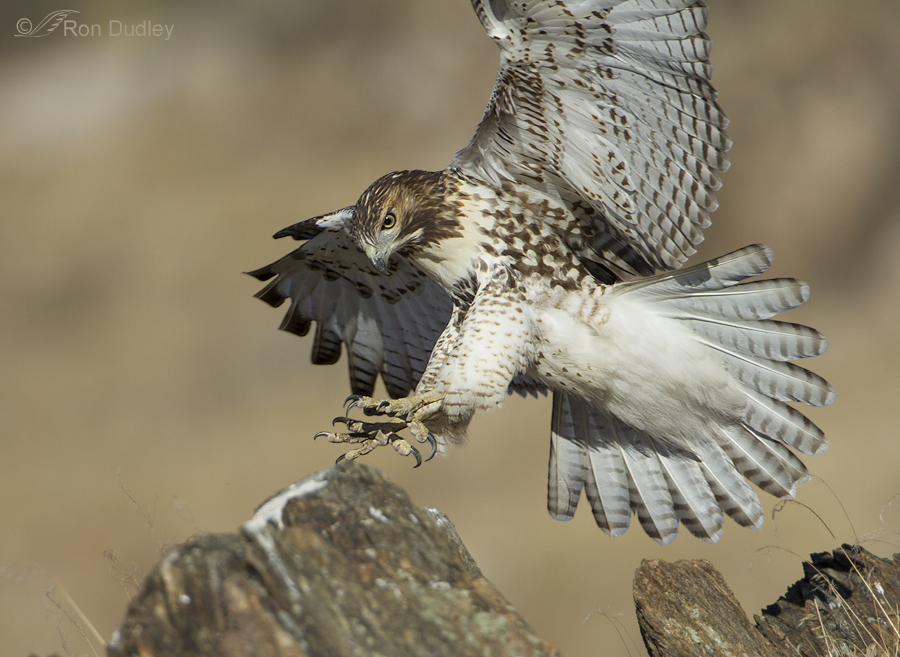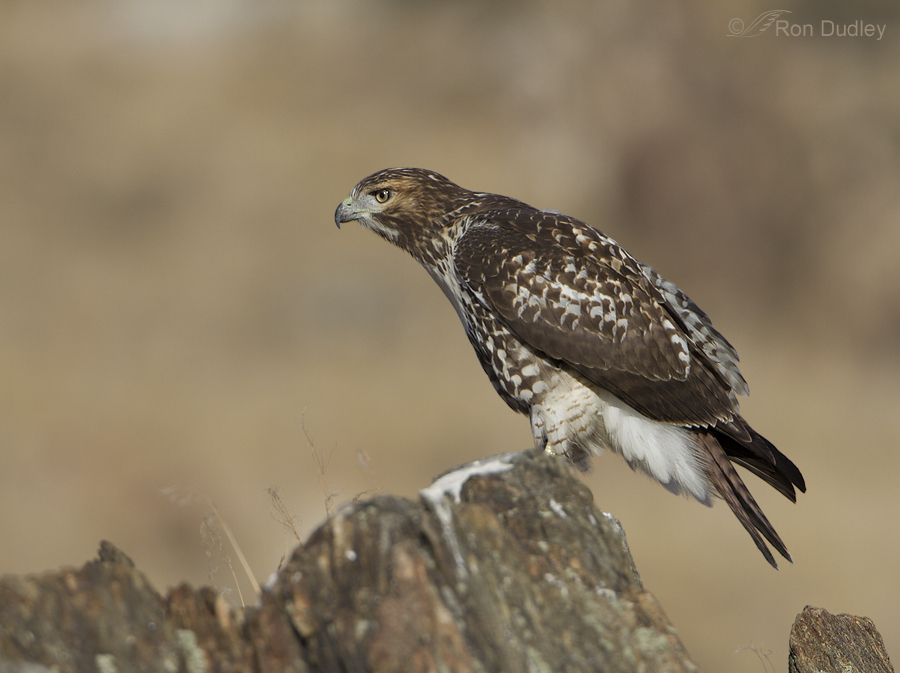Raptor landing shots are one of my most difficult photographic challenges and I attempt them every reasonable chance I get. This one turned out to be unexpectedly interesting, at least from a photographer’s point of view.
1/2000, f/7.1, ISO 400, natural light, not baited, set up or called in
This immature Red-tailed Hawk on Antelope Island chose to land on a rock perch that was too close to me with the teleconverter attached so I cut off a wing (the image is very near full frame) but I still thought the landing pose was pretty neat, especially with the extended talons and the flared tail.
But there’s something visually incongruous about this image – something that just doesn’t fit with everything else that our eyes and brains tell us. Before you scroll down any further, do you see it?
Why isn’t the rock the bird is landing on just as sharp as the hawk? It should be – after all the talons (and much of the rest of the bird) must be in the same focal plane as the rock since they’re apparently touching at this point. The rock isn’t moving, which eliminates motion blur. I have plenty of shutter speed to get the moving bird sharp so why isn’t the stationary rock (or at least the upper part of it that’s in the same focal plane) just as sharp?
1/2000, f/7.1, ISO 400, natural light, not baited, set up or called in
An image taken just after the bird landed reveals the answer. That rock wasn’t the perch after all. The actual perch is another slightly lower rock behind it that we can’t see. It’s just that the position of the talons relative to the foreground rock in the first image unequivocally tells our brains that it is about to be the perch. We have to see evidence like the second image to get things straightened out again – at least I do…
Notice that the smaller rock under and slightly behind the tail is apparently in the same focal plane as the actual perch.
Normally when I attempt landing shots I find it a little easier to prefocus on the perch if I can predict it but this time there were so many potential rock perches in the area that my only real chance was to focus on the bird in flight and hope that I could keep locked on as it landed. In this case, if I had prefocused on what I thought was about to become the perch, the hawk would have been soft.
Ron
Note: When you’re using long lenses your depth of field is surprisingly shallow. For those of you who might like to check the depth of field available with your own camera and lenses, here’s a handy-dandy depth of field calculator that I really like.




Sorry for the duplicate request. I had thought I would be getting an e-mail notification of the response. Thanks for the previously posted information.
I’m in awe of your photographs. Would you mind letting us know what equipment you use: camera, lens, etc.?
Intriguing exercise as always, Ron. For me a reminder that what one sees is necessarily shaped by one’s own experience. I am not a photographer; however, I have kept and handled raptors for many years. Accordingly, I didn’t notice the discrepancy in focus between the bird’s feet and the rock at all. Could have looked for ages and that wouldn’t have registered. What I did notice right away was that the configuration of the hawk’s feet and toes wasn’t right for landing on that presumed perch. No surprise that we all see through the lens of what we know! I love your magnificent images, but I especially enjoy the provocative puzzles you post to make us think. Thank you for both!
An interesting observation on the hawk’s feet, Maya. Yes, we all see the world through our own experiences.
I’m in awe of the quality of your photographs. Inclusion of photographic imformation under your pictures is really helpful as I try to improve my own nature photography skills. Perhaps I’ve missed it, but would you mind telling me what camera you use and whether you generally use a tripod?
Thanks very much, Wally. I use the Canon 7D and seldom use a tripod (very seldom!). I’m nearly always shooting from my pickup window.
Are the tail feathers on the juvenile, immature red tail stripped? When do they get their red feathers? I have a great landing picture of a hawk back side, full wing spread, feet almost down on the ground in a wheat field. Was watching a hawk on the ground with a snake when this one swooped down. Funny thing is the one on the ground fell over on its side and played dead. Once the other landed if stood back up, shook out its feathers and joined the other.
Tanja, I believe their tails turn read at about two years of age and even then the tail is only deeply red on the dorsal (top) surface. I’m no expert, though – perhaps others will weigh in on this.
Wow. The extended talons, the flared tail – and those britches. Be still my beating heart.
Interestingly I had assumed that the hawk was landing lower than the soft rock. I am so rarely right it was an additional bonus – thank you.
Your fascination with “britches” always makes me smile, Elephant’s Child. Thank you.
Thank you.
I could see right away that the hawk was not landing on top of that rock, but I thought it would land in front of it. Now I know to look for an object in the same focal plane as the bird to estimate where it will land.
Thanks! I’m learning so much from your photos and comments.
Thank you, Pam. I learn from shots like this, too.
I love the photo of the hawk landing! I can understand your regret that your photo cropped the view of the wing, but the composition is stunning. And what a gleam in its eye! As you say, the extended talons and flared tail intensify the drama of the shot… The true landing site being obscured did not even occur to me. Thanks for pointing that out so I can be a more observant viewer in the future.
You’re very welcome, Alison.
Clearly I am not a ‘real’ photographer. I, too, was looking for something on the bird. That’s fine with me; I don’t think I have the patience required to photograph birds well. Or to learn how to use a manual camera. Fortunately I am usually happy enough with my snapshots because they usually fulfill my purpose. I love the photo where the bird is about to land. It’s a view most of us will never get to see that clearly.
It’s a view I don’t see very often either, Susan – at least not in this much detail. Glad you enjoyed it.
I can see how most would not ‘get’ the DOF discrepancy. But it’s hard for a photographer to not see it.
Beautiful shot, Ron…as always, and worth sharing (again) on our FB page.
I saw the nice little write-up you did, Rich. Thank you.
Love this one Ron. Lot of drama in a good landing, the need to stay balanced and focus is so important. I once flew Sakura at dusk because it was a late day for me. Having never done this I was unaware of the affect it would have on her ability to stick the landing. To me, the diminished light was marginal, but to her it was critical. She missed so many landings, that I thought something was wrong with her. Realizing it was the light, I called her in. She missed my glove and landed on my shoulder….ouch. lol.
Tim
Fascinating, Tim. I didn’t realize that Sakura’s eyesight would be that compromised in marginal light. But come to think of it I don’t see them hunting in twilight. So different from an owl…
They definately have respect for each other. Hawks will strike Owls during the day, and Owls return the favor at night!
Tim
I really like your photographic demonstration of DOF and its occasional trickiness, Ron. And that online DOF calculator is a gem. I learned unexpectedly how DOF depends on the crop ratio of the sensor when I was first comparing my 7D and my SX50. I took photos of the same scene with both cameras using equal values of f-number and 35-mm equivalent focal length. The SX50 surprised me with its noticeably larger DOF, a result of its itty bitty sensor. Large DOF is often undesirable, of course.
Exactly, Dwynn. As you’re well aware, relatively shallow DOF on your subject is often a good thing because it isolates it from the background and often provides a pleasingly soft bokeh back there. The tradeoff is that sharp focus on your subject becomes critical (and especially difficult on a bird in flight).
Great shot. You teach us so much. I didn’t notice the focus on the rock; I was looking for something on the bird.
Thanks, Ann. I’m glad that you found this helpful,
Just sensational shots Ron! This time, I got it! Yea! Thanks so much for sharing your wonderful talent!
Charlotte
Good, I’m glad you got it, Charlotte. Thank you.